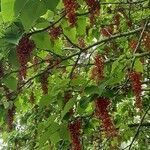A deciduous tree. It grows 12-15 m high. It has a broad crown spreading to 6 m wide. The leaves are large and heart shaped. They are 20 cm long and almost as wide. They taper to the tip. The leaves are dark green above and blue-white underneath and have red stalks. Plants are separately male and female. The flowers are greenish and have a scent. Female plants produce fruit in large hanging clusters. The fruit are pea sized berries. They turn red in autumn.

